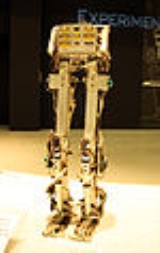
Honda E1
Encyclopedia
The E-series was a collection of successive humanoid robot
s created by the Honda Motor Company between the years of 1986 and 1993. These robots were only experimental, but later evolved into the Honda P series
, with Honda eventually amassing the knowledge and experience necessary to create Honda's advanced humanoid robot: ASIMO
. The fact that Honda had been developing the robots was kept secret from the public until the announcement of the Honda P2
in 1996.
E0, developed in 1986, was the very first robot. It walked in a straight line on two feet, in a manner resembling human locomotion
, taking around 5 seconds to complete a single step. Quickly engineers realised that in order to walk up slopes, the robot would need to travel faster. The model has 6 degrees of freedom: 1 in each groin, 1 in each knee and 1 in each ankle.
Humanoid robot
A humanoid robot or an anthropomorphic robot is a robot with its overall appearance, based on that of the human body, allowing interaction with made-for-human tools or environments. In general humanoid robots have a torso with a head, two arms and two legs, although some forms of humanoid robots...
s created by the Honda Motor Company between the years of 1986 and 1993. These robots were only experimental, but later evolved into the Honda P series
Honda P series
The P-series is a chronological progression of prototype humanoid robots as developed by Honda. The research conducted allowed the eventual creation of ASIMO.*P1 developed in 1993*P2 unveiled in 1996*P3 unveiled in 1997Notes:- See also :...
, with Honda eventually amassing the knowledge and experience necessary to create Honda's advanced humanoid robot: ASIMO
ASIMO
is a humanoid robot created by Honda. Introduced in 2000, ASIMO, which is an acronym for "Advanced Step in Innovative MObility", was created to be a helper to people. With aspirations of helping people who lack full mobility, ASIMO is used to encourage young people to study science and mathematics...
. The fact that Honda had been developing the robots was kept secret from the public until the announcement of the Honda P2
Honda P series
The P-series is a chronological progression of prototype humanoid robots as developed by Honda. The research conducted allowed the eventual creation of ASIMO.*P1 developed in 1993*P2 unveiled in 1996*P3 unveiled in 1997Notes:- See also :...
in 1996.
E0, developed in 1986, was the very first robot. It walked in a straight line on two feet, in a manner resembling human locomotion
Animal locomotion
Animal locomotion, which is the act of self-propulsion by an animal, has many manifestations, including running, swimming, jumping and flying. Animals move for a variety of reasons, such as to find food, a mate, or a suitable microhabitat, and to escape predators...
, taking around 5 seconds to complete a single step. Quickly engineers realised that in order to walk up slopes, the robot would need to travel faster. The model has 6 degrees of freedom: 1 in each groin, 1 in each knee and 1 in each ankle.
Models
- E0 developed in 1986
- E1, developed in 1987, was larger than the first and walked at 0.25 km/h. This model and subsequent E-series robots have 12 degrees of freedom: 3 in each groin, 1 in each knee and 2 in each ankle.
- E2, developed in 1989, could travel at 1.2km/h, through the development of 'dynamic movement.'
- E3, developed in 1991, travelled at 3km/h, the average speed of a walking human.
- E4, developed in 1991, lengthened the knee to achieve speeds of up to 4.7km/h
- E5, developed in 1992, was able to walk autonomously, albeit with a very large head
- E6, developed in 1993, was able to autonomously balance, walk over obstacles, and even climb stairs
| E0 (1986) |
E1 (1987) |
E2 (1989) |
E3 (1991) |
E4 (1991) |
E5 (1992) |
E6 (1993) |
-> | P1 Honda P series The P-series is a chronological progression of prototype humanoid robots as developed by Honda. The research conducted allowed the eventual creation of ASIMO.*P1 developed in 1993*P2 unveiled in 1996*P3 unveiled in 1997Notes:- See also :... (1993) |
|---|---|---|---|---|---|---|---|---|
| Weight | 16.5 kg | 72 kg | 67.7 kg | 86 kg | 150 kg | 150 kg | 150 kg | 175 kg |
| Height | 101.3 cm | 128.8 cm | 132 cm | 136.3 cm | 159.5 cm | 170 cm | 174.3 cm | 191.5 cm |
| Degrees of freedom | 6 | 12 | 12 | 12 | 12 | 12 | 12 | 30 (12 in legs) |
| Image |  |
 |
 |
 |
 |
 |
 |
 |
External links
- History of humanoid robots - Honda official website

